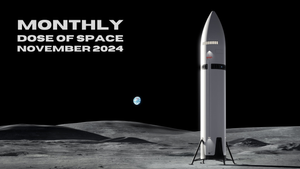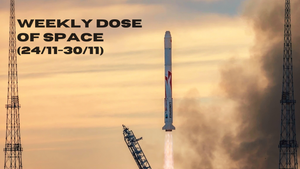
Weekly Dose of Space (9/6-15/6)
Welcome back to Weekly Dose of Space! Last week saw zero orbital launch attempts worldwide. Despite the lack of launches, this week saw a new country sign onto the Artemis Accords, a Moon rocket begin a new testing phase, and the passing of two space legends.
SpaceX
This week at Starbase began on the 11th when workers were spotted removing thermal protection tiles near the nose of Ship 30, all of Ship 30's tiles are believed to be replaced ahead of flight five. That same day, parts for a new CC 8800-1 crane were delivered and unloaded at the construction site of Orbital Pad B.
The following day on June 12th, Ship 26 returned to the production site from the Massey's test site, it had recently tested a new static fire stand. More parts for the CC 8800-1 crane were also delivered on the 12th. The 12th also saw the 'chopsticks' landing rail perform testing possibly ahead of the fifth flight, this rail dampens the boosters landing on the 'chopsticks'.
Work on the base of the second orbital launch tower at the launch site began on the 13th, with two of the bases for tower sections being installed by the 14th. Walls for the base of the tower were installed between these two points not long after. By the 14th, Ship 30 had a large number of its thermal protection tiles entirely removed.
Launches This Week
For the first time since we began publishing Weekly Doese of Space, no orbital launches have occurred in the last week. SpaceX had been planning to launch two Starlink missions and one customer mission, these have since been delayed with one of the Starlink launches scrubbing its launch at T-0.
In Other Space News
Bill Anders, Apollo 8 astronaut, killed in plane crash at 90

Bill Anders, Apollo 8 astronaut and photographer behind the famous Earthrise photo, was confirmed to have been killed in a plane crash on June 7th at the age of 90. Anders was confirmed to have been the pilot of a crashed Beechcraft T-34 Mentor aircraft off the coast of Jones Island in San Juan Channel.
Anders was selected as a NASA astronaut in 1963 and flew his only mission in 1968, which was Apollo 8 on a trip to lunar orbit. During his six-day mission, he captured the famous Earthrise photo while in lunar orbit for 20 hours.
During his life Anders was awarded many medals and awards with a few being: NASA's Distinguished Service Medal, the U.S. Air Force's Distinguished Service Medal, the National Geographic Society's Hubbard Medal for Exploration, and the American Astronautical Society's Flight Achievement Award.
Wang Yongzhi, Chinese space pioneer, dies at 91

Wang Yongzhi, a leading mind behind China's crewed spaceflight missions, passed away on June 11th. During his career, Wang served as the Chief Designer of China's Manned Space Program between 1992 and 2007, and oversaw the first six Shenzhou missions.
Wang's career with China's aerospace efforts started in 1961 when he joined the China Academy of Launch Vehicle Technology, formerly the Ministry of National Defense's Fifth Academy, where he helped develop domestic rocketry technology. In 1978 he was appointed as the head of the General Design Department of the China Academy of Launch Vehicle Technology and later became the president of the Academy in 1986.
Over his decades-long career, Wang received many awards and honors with a few being: the National Science Conference Award in 1978, the National Highest Science and Technology Award in 2003, the People's Liberation Army First-Class Hero and Model Medal in 2005, and the honorary title of "Meritorious Scientist of Manned Spaceflight" in 2005.
International Space Station has emergency scare

On June 12th audio from a training simulation on the ground was accidentally aired on NASA's live broadcast from the International Space Station indicating that a crew member was experiencing decompression sickness. At the time of the simulation airing, crew members onboard were in an allocated sleep period with no real emergency present.
NASA issued a statement about the accidental public airing of a simulation on X via the Internation Space Station account which reads as follows:
There is no emergency situation going on aboard the International Space Station. At approximately 5:28 p.m. CDT, audio was aired on the NASA livestream from a simulation audio channel on the ground indicating a crew member was experiencing effects related to decompression sickness (DCS). This audio was inadvertently misrouted from an ongoing simulation where crew members and ground teams train for various scenarios in space and is not related to a real emergency.
Long March 10 begins new testing wave
Another clip of the CZ-10’s hot fire test pic.twitter.com/iD4rz1VLxI
— Ace of Razgriz (@raz_liu) June 14, 2024
The three-engine hot fire test via raz_liu on X.
On June 14th, three YF-100K engines were ignited in China, beginning a new wave of testing for the Long March 10 launch vehicle, which will be used for initial crewed lunar missions. The engines produced a total of 382 tons of thrust, or approximately 127 tons each, while demonstrating stable start-up and shutdown. The test used only three engines likely due to it occurring on an older stand that may or may not have been rated to withstand the full thrust of all seven engines. Another test with the remaining four engines is rumored to occur soon.
According to the China Academy of Launch Vehicle Technology, the test verified propellant loading, engine fuelling systems, and combined engine start-up procedures.
Armenia becomes 43rd Artemis Accord Signatory

Armenia became the forty-third country to sign onto the U.S.-led Artemis Accords on June 12th with Mkhitar Hayrapetyan, Minister of High-Tech Industry of the Republic of Armenia, signing on behalf of Armenia. After signing Hayrapetyan said:
“By signing these accords, Armenia joins a community of nations dedicated to advancing the frontiers of human knowledge and capability in space,” – “Our involvement will not only enhance our technological capabilities, but also inspire a new generation of Armenians to dream big, to innovate and to explore the world and universe.”
The signing took place in Washington D.C. at NASA Headquarters.
What to Expect Next Week
Starbase
SpaceX is already gearing up for the fifth flight of Starship-Super Heavy with the aspirational launch date being sometime in July. The Federal Aviation Administration has also confirmed that a mishap investigation will not need to be completed ahead of the fifth flight, so minimal regulatory issues will slow hold up the flight unless SpaceX decides to change to flight plan to something dissimilar to flight four.
June 18th - Electron for 'No Time Toulouse'
Electron is expected to liftoff from Launch Complex 1B, located on the Māhia Peninsula in New Zealand, carrying five satellites to low Earth orbit for the French Kinéis 'Internet of Things' constellation.
June 18th - Falcon 9 with Astra 1P/SES-24
A Falcon 9 is believed to be targeting launch on the 15th carrying the Astra 1P/SES-24 satellites to a geostationary transfer orbit from Space Launch Complex 40, in Florida. The booster for this mission is currently unknown but it is expected to land downrange on one of SpaceX's drone ships.
June 19th - Falcon 9 with Starlink Group 9-1
SpaceX is also believed to be targeting June 14th for the launch of the Starlink Group 9-1 atop of a Falcon 9 from Space Launch Complex 4E, in California. The booster for this mission is also currently unknown but it is expected to land on the drone ship 'Of Course I Still Love You'.
June 22nd - Long March 2C with SVOM
A Long March 2C is expected to launch from the Xichang Satellite Launch Center carrying the SVOM, Space Variable Objects Monitor, spacecraft into a low Earth orbit. The spacecraft is an X-ray telescope that will study gamma-ray bursts and was developed by the China National Space Administration and France's Centre National d'Études Spatiales.




